Some historical photos
We recently had a twentieth birthday, to which many of the employees sent old photographs. Some are very interesting: you can literally walk through them year after year through the domestic history of IT.
So, for example, a super-fashioned "netbook" of the 1992 model. Please note that the laptop did not yet occupy a central place on the table: the paper for several years remained no less important. There was no network, so a printer was attached to every computer.

Caution, under the cut traffic
And here is our laboratory for the development of new solutions in the same 1992. This is actually much closer to modernity than it seems: there were already mice, computers resembled the Lego constructor, and not the “young electrical engineer” set, although only those who proved their professional suitability were allowed to approach them. And by the way, if there was a computer in the room, this is definitely not a typical office. Only five years from now, this will become common.
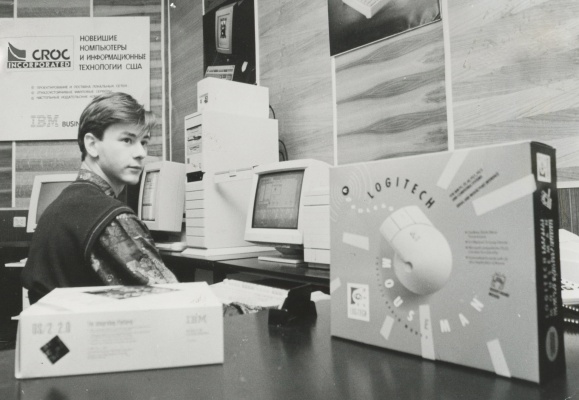
Our sales director “makes onions,” as they would say today. Everything that’s cool is ushanka, fashionable Volga, no extra gadgets ...

“Microcircuits with an area of more than 1 square meter cannot be taken out of the research institute!” - this is the 95th year, then taking pictures with such a piece of iron was then almost as cool as with a spaceship.
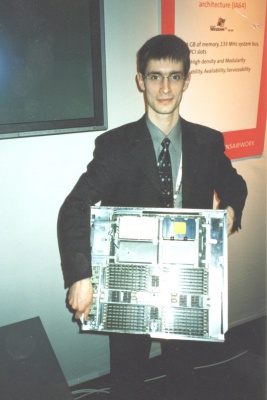
And this is 1996: if you imagine a color photograph, then, in principle, this can be seen somewhere in distant regions today. And if you close the right side of the photo with your hand, you can see something close in spirit to the 60th.
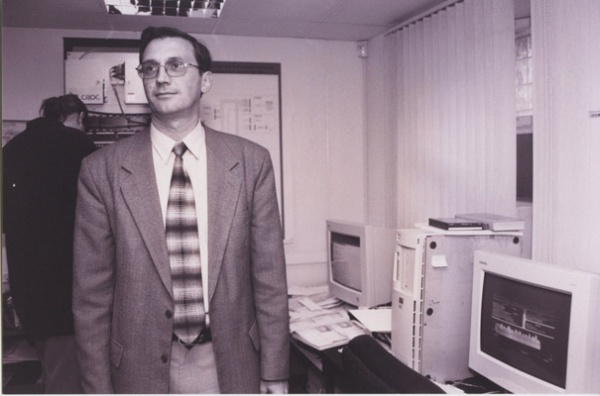
In the same year: this is a "run", that is, testing computers after assembly. It was rather simple to assemble the system unit, but there were still bugs of compatibility of iron and just “moon phases” during production, so before sending to the customer all the hardware was tested.

Marketing department: already at that time we had so many ready-made projects that the shelves simply burst with leaflets: after all, this is the heyday of the IT industry in Russia.
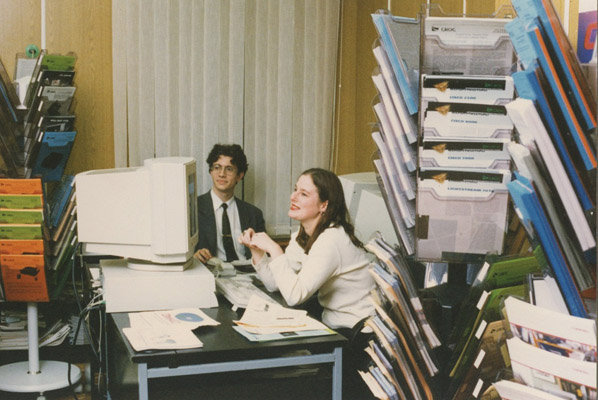
1997: our first “demo room” and its main patron of those years.
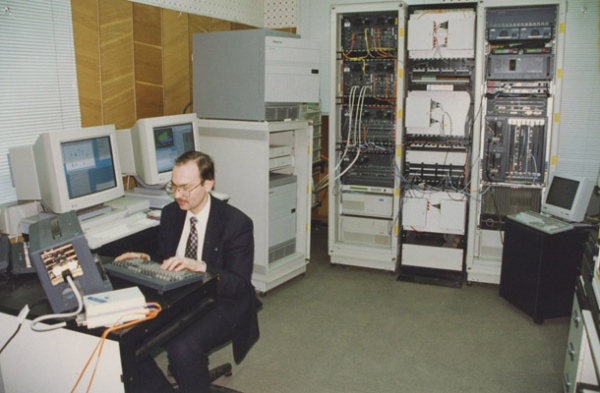
Around this period, the building of our futurethe third data center was still stopping by the train to unload:

Two photos from the 98th year: almost modern by the standards of IT.
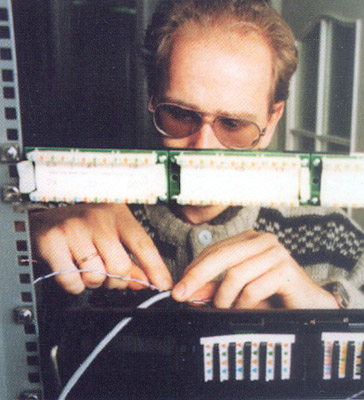
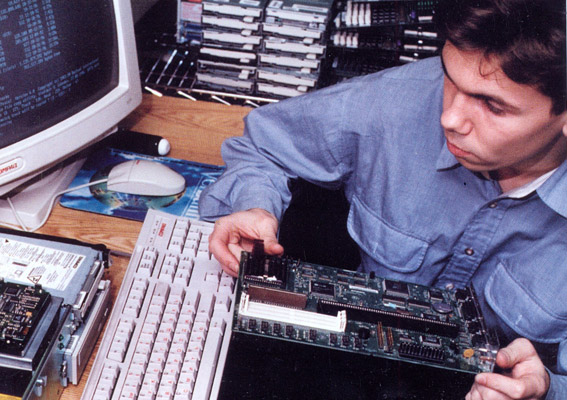
Year 2002: this is what a modern office looked like. IT people have ceased to be perceived as bearded people in sweaters.
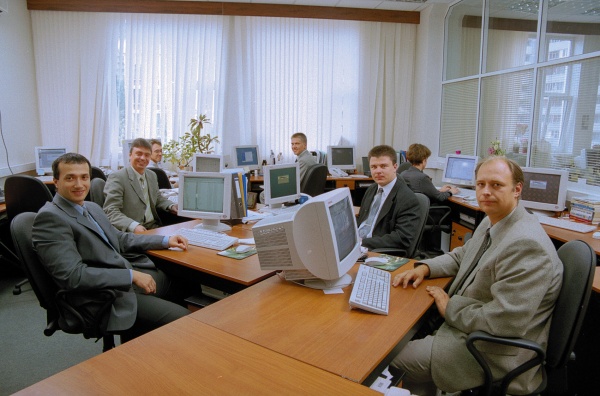
2003: testing and repair zone: “sick” equipment was brought here, some of which had to be repaired with a soldering iron and some kind of mother: modular components were not always enough in our country.
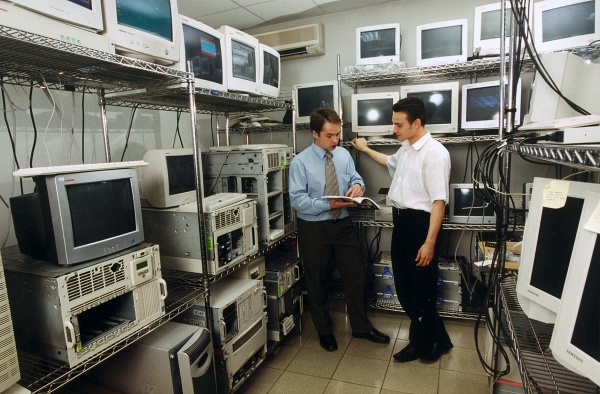
This is what the server room looked like in 2004. Pay attention to the monitor that the server still needed (in practice).
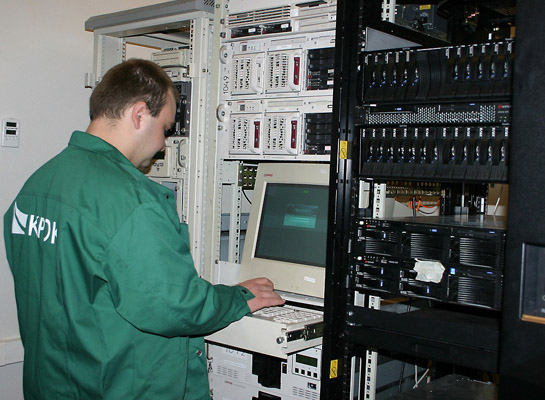
Helpdesk in 2004: headsets were then associated with military and space films and were just starting to come into use. Monitors in offices have become flat, and photos have become digital.
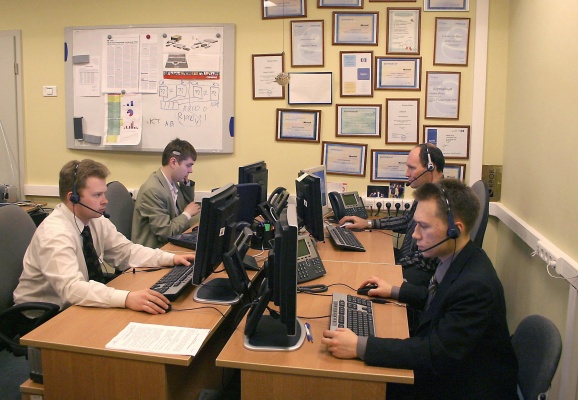
In 2006, they began to build a new office building:
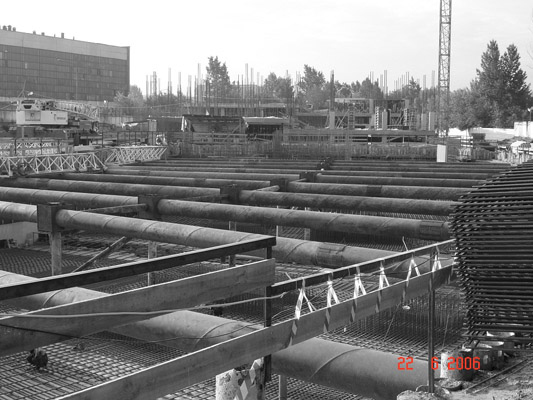
and in 2008 they finally moved to their own 11-story office with a bunch of interesting "tricks": energy-saving air conditioning and heating systems, automatic control of external lighting, automated building management and more.

By the 2010s, IT professionals are finally moving away from the image of geeks: within the company, we support hobbies, creativity, and sports. Our experts take a couple of interesting achievements - for example, Elbrus.

In 2012, we celebrated the twentieth anniversary and finally “finished off” the stereotype that the IT specialist is necessarily a man. In the picture, everyone is an employee of the company.

Actually, that's all. Almost all the employees from the photos today are people behind whom hundreds of successful IT projects that would have seemed like real fiction to people from 1992 are behind them.
In just a couple of decades, the world had changed right before their eyes, and even the processors of ordinary cameras and telephones became hundreds of times faster than the computers of that time controlling orbiting satellites.
So, for example, a super-fashioned "netbook" of the 1992 model. Please note that the laptop did not yet occupy a central place on the table: the paper for several years remained no less important. There was no network, so a printer was attached to every computer.

Caution, under the cut traffic
And here is our laboratory for the development of new solutions in the same 1992. This is actually much closer to modernity than it seems: there were already mice, computers resembled the Lego constructor, and not the “young electrical engineer” set, although only those who proved their professional suitability were allowed to approach them. And by the way, if there was a computer in the room, this is definitely not a typical office. Only five years from now, this will become common.

Our sales director “makes onions,” as they would say today. Everything that’s cool is ushanka, fashionable Volga, no extra gadgets ...

“Microcircuits with an area of more than 1 square meter cannot be taken out of the research institute!” - this is the 95th year, then taking pictures with such a piece of iron was then almost as cool as with a spaceship.

And this is 1996: if you imagine a color photograph, then, in principle, this can be seen somewhere in distant regions today. And if you close the right side of the photo with your hand, you can see something close in spirit to the 60th.

In the same year: this is a "run", that is, testing computers after assembly. It was rather simple to assemble the system unit, but there were still bugs of compatibility of iron and just “moon phases” during production, so before sending to the customer all the hardware was tested.

Marketing department: already at that time we had so many ready-made projects that the shelves simply burst with leaflets: after all, this is the heyday of the IT industry in Russia.

1997: our first “demo room” and its main patron of those years.

Around this period, the building of our futurethe third data center was still stopping by the train to unload:

Two photos from the 98th year: almost modern by the standards of IT.


Year 2002: this is what a modern office looked like. IT people have ceased to be perceived as bearded people in sweaters.

2003: testing and repair zone: “sick” equipment was brought here, some of which had to be repaired with a soldering iron and some kind of mother: modular components were not always enough in our country.

This is what the server room looked like in 2004. Pay attention to the monitor that the server still needed (in practice).

Helpdesk in 2004: headsets were then associated with military and space films and were just starting to come into use. Monitors in offices have become flat, and photos have become digital.

In 2006, they began to build a new office building:

and in 2008 they finally moved to their own 11-story office with a bunch of interesting "tricks": energy-saving air conditioning and heating systems, automatic control of external lighting, automated building management and more.

By the 2010s, IT professionals are finally moving away from the image of geeks: within the company, we support hobbies, creativity, and sports. Our experts take a couple of interesting achievements - for example, Elbrus.

In 2012, we celebrated the twentieth anniversary and finally “finished off” the stereotype that the IT specialist is necessarily a man. In the picture, everyone is an employee of the company.

Actually, that's all. Almost all the employees from the photos today are people behind whom hundreds of successful IT projects that would have seemed like real fiction to people from 1992 are behind them.
In just a couple of decades, the world had changed right before their eyes, and even the processors of ordinary cameras and telephones became hundreds of times faster than the computers of that time controlling orbiting satellites.
